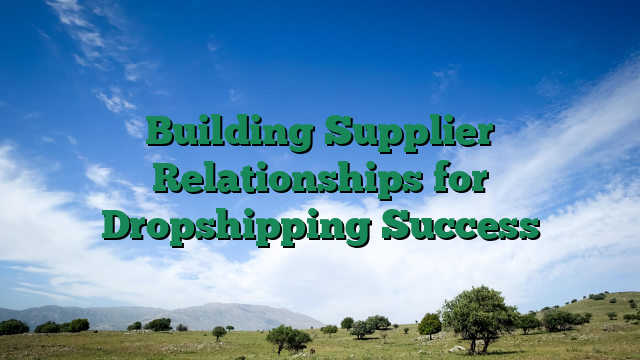Building Supplier Relationships for Dropshipping Success
Starting a dropshipping business is exciting, but let’s be real—your success hinges on one critical factor: supplier management. Without reliable suppliers, your inventory, shipping, and customer satisfaction can fall apart faster than a poorly packed parcel.
I remember my first dropshipping venture. I was thrilled to launch my store, only to face delayed shipments and subpar products. It wasn’t until I focused on building strong supplier relationships that things turned around. Today, I’ll share actionable tips to help you vet suppliers, communicate effectively, negotiate terms, and manage inventory updates like a pro.
By the end of this post, you’ll not only have a blueprint for supplier management but also discover how to monetize your dropshipping knowledge and turn it into a side hustle. Let’s dive in!
1. Vetting Suppliers: The Foundation of Dropshipping Success
Your supplier is the backbone of your business. Choosing the wrong one can lead to headaches, while the right one can set you up for long-term success. Here’s how to vet suppliers effectively:
Research Their Reputation
Start by checking reviews and ratings on platforms like AliExpress, Oberlo, or Spocket. Look for suppliers with a track record of reliability and positive feedback.
Test Their Products
Order samples to assess product quality and shipping times. This step is non-negotiable—don’t skip it!
Evaluate Communication
Reach out to potential suppliers with questions. A responsive supplier is more likely to handle issues promptly.
Pro Tip: Use tools like to analyze supplier data and verify their credibility.
2. Communication Strategies: Building Trust and Transparency
Once you’ve chosen a supplier, the next step is to establish clear and consistent communication. Here’s how to do it:
Set Expectations Early
Clearly outline your requirements for product quality, packaging, and shipping times. A detailed agreement can prevent misunderstandings later.
Use Multiple Channels
Don’t rely solely on email. Use messaging apps like WhatsApp or Skype for faster responses.
Schedule Regular Check-Ins
Monthly or quarterly meetings can help you stay updated on inventory levels and address any concerns.
Real-World Example: One of my clients doubled their sales by simply scheduling weekly updates with their supplier. This ensured they always had the latest inventory data and avoided stockouts.
3. Negotiating Terms: Win-Win Deals for Long-Term Success
negotiation isn’t about squeezing every penny out of your supplier—it’s about creating a partnership that benefits both parties. Here’s how to negotiate like a pro:
Start Small
If you’re new to dropshipping, focus on building trust before asking for discounts. Once you’ve proven your reliability, suppliers are more likely to offer better terms.
Leverage Volume
As your business grows, use your order volume as a bargaining chip. Suppliers are often willing to lower prices for bulk orders.
Be Flexible
Sometimes, offering longer payment terms or committing to a minimum order quantity can help you secure better deals.
Actionable Tip: Always have a backup supplier. This gives you leverage during negotiations and ensures you’re not left stranded if things go south.
4. Managing Inventory Updates: Staying Ahead of the Game
inventory management is one of the trickiest aspects of dropshipping. Here’s how to stay on top of it:
Use Automation Tools
Platforms like Shopify and WooCommerce integrate with apps like Oberlo or Spocket to sync inventory in real-time.
Monitor Stock Levels
Set up alerts for low stock levels and communicate with your supplier to avoid delays.
Plan for Peak Seasons
Holidays and sales events can strain your supply chain. Work with your supplier to ensure they’re prepared for increased demand.
Pro Tip: Diversify your product range to reduce reliance on a single supplier. This minimizes risk and keeps your store fresh.
Conclusion: Your Blueprint to Dropshipping Success
Building strong supplier relationships is the secret sauce to dropshipping success. By vetting suppliers, communicating effectively, negotiating terms, and managing inventory updates, you’ll create a reliable foundation for your business.
But here’s the kicker: the skills you’ve learned today aren’t just for your dropshipping store. They’re transferable to other online ventures, making them a valuable asset for monetization.
Monetization Potential
- Create a Course: Share your supplier management expertise through an online course. Platforms like Udemy or Teachable make it easy to get started.
- Write an E-Book: Compile your tips into a downloadable guide and sell it on your website or Amazon.
- Offer Consulting: Help other dropshippers navigate supplier relationships for a fee.
Side Hustle Ideas
- Start a blog or YouTube channel focused on dropshipping tips.
- Launch a dropshipping mentorship program.
- Build a community of like-minded entrepreneurs and charge a membership fee.
At TheBizWizAcademy.com, we’re all about empowering entrepreneurs like you to turn knowledge into income. Our courses and community provide the tools and support you need to succeed. Ready to take your dropshipping game to the next level? Join us today and start building your online business blueprint!
By following these strategies, you’ll not only master supplier management but also unlock new opportunities for growth and monetization. Remember, success in dropshipping isn’t just about selling products—it’s about building relationships and creating value. You’ve got this! 🚀
🚀 Want to level up your online business? Join TheBizWizAcademy and start Networking and Learning!
